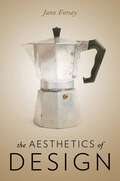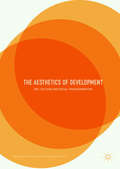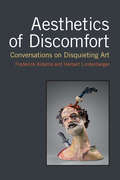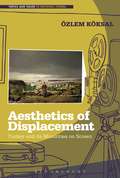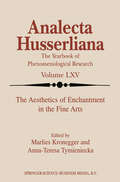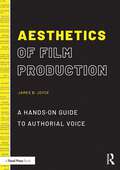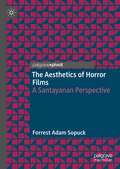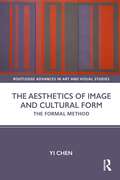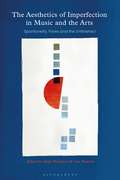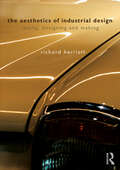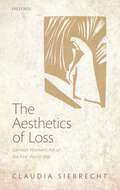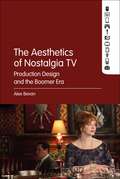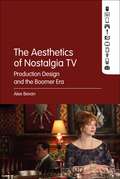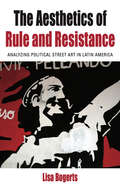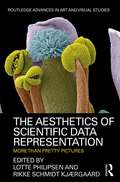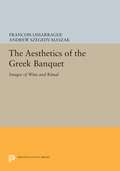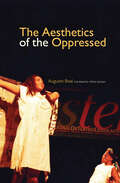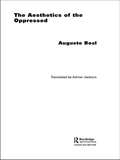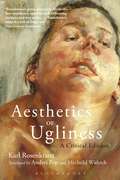- Table View
- List View
The Aesthetics of Design
by Jane ForseyThe Aesthetics of Design offers the first full treatment of design in the field of philosophical aesthetics. Aesthetic theory has traditionally occupied itself with fine art in all its forms, sometimes with craft, and often with notions of beauty and sublimity in art and nature. In so doing, it has largely ignored the quotidian and familiar objects and experiences that make up our daily lives. Yet how we interact with design involves aesthetic choices and judgements as well as practical, cognitive and moral considerations. This work challenges the discipline to broaden its scope to include design, and illustrates how aesthetics helps define our human concerns. Subjecting design to as rigorous a treatment as any other aesthetic object exposes it to three main challenges that form the core of this book. First, design must be distinguished from art and craft as a unique kind of object meriting separate philosophical attention, and is here defined in part by its functional qualities. Second, the experience of design must be defended as having a particularly aesthetic nature. Here Forsey adapts the Kantian notion of dependent beauty to provide a model for our appreciation of design as different from our judgements of art, craft and natural beauty. Finally, design is important for aesthetics and philosophy as a whole in that it is implicated in broader human concerns. Forsey situates her theory of design as a constructive contribution to the recent movement of Everyday Aesthetics, which seeks to re-enfranchise philosophical aesthetics as an important part of philosophy at large.
The Aesthetics of Development: Art, Culture and Social Transformation
by John Clammer Ananta Kumar GiriThrough a unique range of theoretical and practical case studies, this collection considers the relationship between the arts (understood as the visual arts, crafts, theatre, dance, and literature) and development, creating both a bridge between them that is rarely explored and filling in concrete ways the content of the “culture” part of the equation “culture and development”. It includes manifestations of culture and the ways in which they relate to development, and in turn contribute to such pressing issues as poverty alleviation, concern for the environment, health, empowerment, and identity formation. It shows how the arts are an essential part of the concrete understanding of culture, and as such a significant part of development thinking - including the development of culture, and not only of culture as an instrumental means to promote other development goals.
Aesthetics of Discomfort: Conversations on Disquieting Art
by Frederick L Aldama Herbert S LindenbergerThrough a series of provocative conversations, Frederick Luis Aldama and Herbert Lindenberger, who have written widely on literature, film, music, and art, locate a place for the discomforting and the often painfully unpleasant within aesthetics. The conversational format allows them to travel informally across many centuries and many art forms. They have much to tell one another about the arts since the advent of modernism soon after 1900—the nontonal music, for example, of the Second Vienna School, the chance-directed music and dance of John Cage and Merce Cunningham, the in-your-faceness of such diverse visual artists as Francis Bacon, Pablo Picasso, Willem de Kooning, Egon Schiele, Otto Dix, and Damien Hirst. They demonstrate as well a long tradition of discomforting art stretching back many centuries, for example, in the Last Judgments of innumerable Renaissance painters, in Goya’s so-called “black” paintings, in Wagner’s Tristan chord, and in the subtexts of Shakespearean works such as King Lear and Othello. This book is addressed at once to scholars of literature, art history, musicology, and cinema. Although its conversational format eschews the standard conventions of scholarly argument, it provides original insights both into particular art forms and into individual works within these forms. Among other matters, it demonstrates how recent work in neuroscience may provide insights in the ways that consumers process difficult and discomforting works of art. The book also contributes to current aesthetic theory by charting the dialogue that goes on—especially in aesthetically challenging works—between creator, artifact, and consumer.
Aesthetics of Displacement: Turkey and its Minorities on Screen (Topics and Issues in National Cinema)
by Ozlem KoksalDisplacement does not only have an effect on groups' and individuals' ways of relating to their identity and their past but the knowledge and experience of it also has an impact on its representation. Looking at films that represent the experience of displacement in relation to Turkey's minorities, Aesthetics of Displacement argues that there is a particular aesthetic continuity among the otherwise unrelated films. Ozlem Koksal focuses on films that bring taboo issues concerning the repression of minorities into visibility, arguing that the changing political and social conditions determine not only the types of stories told but also the ways in which these stories are told.Focusing on aesthetic and narrative continuities, the films discussed include Ararat, Waiting for the Clouds and Once Upon a Time in Anatolia among others. Each film is examined in light of major historical event(s) and their context (political and social) as well as the impact these events had on the construction of both minority and Turkish identity.
The Aesthetics of Enchantment in the Fine Arts (Analecta Husserliana #65)
by Marlies Kronegger Anna-Teresa TymienieckaLet us revive the true sense of fine arts: enchantment! In the conceptualised, commercialised, artificial approach to fine arts, we forgot its authentic experiential sense. It lies at the imaginative heart of all arts there to be retrieved by the creative recipient as the very 'truth of it all'.
Aesthetics of Film Production: A Hands-On Guide to Authorial Voice
by James B. JoyceExploring aesthetic decision-making skills through active, critical interpretation of the screenplay, this book investigates the ways filmmakers translate a screenplay into a powerful film. Guiding the reader through the formal choices a filmmaker makes, this book encompasses all aspects of the filmmaking process, including directing, acting, cinematography, lighting, production design, sound, and editing. Author Joyce illustrates how to apply aesthetics in a way that encourages creative thinking and stylistic choices, while emphasizing the importance of active decision-making to foreground the screenplay in the filmmaking process. Focusing on how films should be crafted stylistically from beat to beat, the book provides tangible footholds to assist filmmakers with the aesthetic decision-making process, empowering filmmakers to create films to resonate emotionally and intellectually. Ideal for students of filmmaking and aspiring filmmakers looking to train their gut and hone their creative and aesthetic decision-making in the filmmaking process. Additional online screenplay samples show how one singular story can be told with different emphasis and narrative perspectives.
Aesthetics of Film Production: A Hands-On Guide to Authorial Voice
by James B. JoyceExploring aesthetic decision-making skills through active, critical interpretation of the screenplay, this book investigates the ways filmmakers translate a screenplay into a powerful film. Guiding the reader through the formal choices a filmmaker makes, this book encompasses all aspects of the filmmaking process, including directing, acting, cinematography, lighting, production design, sound, and editing. Author Joyce illustrates how to apply aesthetics in a way that encourages creative thinking and stylistic choices, while emphasizing the importance of active decision-making to foreground the screenplay in the filmmaking process. Focusing on how films should be crafted stylistically from beat to beat, the book provides tangible footholds to assist filmmakers with the aesthetic decision-making process, empowering filmmakers to create films to resonate emotionally and intellectually. Ideal for students of filmmaking and aspiring filmmakers looking to train their gut and hone their creative and aesthetic decision-making in the filmmaking process. Additional online screenplay samples show how one singular story can be told with different emphasis and narrative perspectives.
The Aesthetics of Horror Films: A Santayanan Perspective
by Forrest Adam SopuckThis book analyzes the nature and functions of horror films from the vantage of a theoretical reconstruction of George Santayana’s account of beauty. This neo-Santayanan framework forms the conceptual backdrop for a new model of horror’s aesthetic enjoyment, the nature of which is detailed through the examination of plot, cinematic, and visual devices distinctive of the popular genre. According to this model, the audience derives pleasure from the films through confronting the aversive scenarios they communicate and rationalizing a denial of their personal applicability. The films then come to embody these acts of self-assertion and intellectual overcoming and become objects of pride. How horror films can acquire necropolitical functions within the context of abusive systems of power is also clarified. These functions, which exploit the power of anti-tragedy, downward social comparison, or vicarious emotion, work to remediate aggressive, ascetic, or revolutionary impulses in ways that are not injurious to the status quo. This book champions horror as a source of self-empowerment and unmitigated beauty, but also attests to the potential social harms of the genre.
The Aesthetics of Image and Cultural Form: The Formal Method (Routledge Advances in Art and Visual Studies)
by Yi ChenOffering an alternative mode of visual cultural analysis to the prevalent discursive model, this book proposes to situate analysis of Image within ‘formal’ analyses of culture experience.Specifically, the discussion draws on theories of affective aesthetics with the view of addressing the sensual form of culture (i.e. ‘cultural form’). Therefore, the volume puts forward a mode of formalist analysis in visual cultural research which takes purchase on the idea of ‘cultural form’. A continuum of formalist attention between Image analysis (visual media, industrial design) and probing of ‘cultural forms’ establishes the theoretical underpinning of the book. These concepts are expounded through a case study which looks at formal experimentations and debates arising from 1960s avant-garde artistic practices in London.
The Aesthetics of Image and Cultural Form: The Formal Method (Routledge Advances in Art and Visual Studies)
by Yi ChenOffering an alternative mode of visual cultural analysis to the prevalent discursive model, this book proposes to situate analysis of Image within ‘formal’ analyses of culture experience.Specifically, the discussion draws on theories of affective aesthetics with the view of addressing the sensual form of culture (i.e. ‘cultural form’). Therefore, the volume puts forward a mode of formalist analysis in visual cultural research which takes purchase on the idea of ‘cultural form’. A continuum of formalist attention between Image analysis (visual media, industrial design) and probing of ‘cultural forms’ establishes the theoretical underpinning of the book. These concepts are expounded through a case study which looks at formal experimentations and debates arising from 1960s avant-garde artistic practices in London.
The Aesthetics of Imperfection in Music and the Arts: Spontaneity, Flaws and the Unfinished
by Andy Hamilton and Lara PearsonThe aesthetics of imperfection emphasises spontaneity, disruption, process and energy over formal perfection and is often ignored by many commentators or seen only in improvisation. This comprehensive collection is the first time imperfection has been explored across all kinds of musical performance, whether improvisation or interpretation of compositions. Covering music, visual art, dance, comedy, architecture and design, it addresses the meaning, experience, and value of improvisation and spontaneous creation across different artistic media. A distinctive feature of the volume is that it brings together contributions from theoreticians and practitioners, presenting a wider range of perspectives on the issues involved. Contributors look at performance and practice across Western and non-Western musical, artistic and craft forms. Composers and non-performing artists offer a perspective on what is 'imperfect' or improvisatory within their work, contributing further dimensions to the discourse. The Aesthetics of Imperfection in Music and the Arts features 39 chapters organised into eight sections and written by a diverse group of scholars and performers. They consider divergent definitions of aesthetics, employing both 18th-century philosophy and more recent socially and historically situated conceptions making this an essential, up-to-date resource for anyone working on either side of the perfection-imperfection debate.
The Aesthetics of Imperfection in Music and the Arts: Spontaneity, Flaws and the Unfinished
The aesthetics of imperfection emphasises spontaneity, disruption, process and energy over formal perfection and is often ignored by many commentators or seen only in improvisation. This comprehensive collection is the first time imperfection has been explored across all kinds of musical performance, whether improvisation or interpretation of compositions. Covering music, visual art, dance, comedy, architecture and design, it addresses the meaning, experience, and value of improvisation and spontaneous creation across different artistic media. A distinctive feature of the volume is that it brings together contributions from theoreticians and practitioners, presenting a wider range of perspectives on the issues involved. Contributors look at performance and practice across Western and non-Western musical, artistic and craft forms. Composers and non-performing artists offer a perspective on what is 'imperfect' or improvisatory within their work, contributing further dimensions to the discourse. The Aesthetics of Imperfection in Music and the Arts features 39 chapters organised into eight sections and written by a diverse group of scholars and performers. They consider divergent definitions of aesthetics, employing both 18th-century philosophy and more recent socially and historically situated conceptions making this an essential, up-to-date resource for anyone working on either side of the perfection-imperfection debate.
The Aesthetics of Industrial Design: Seeing, Designing and Making
by Richard HerriottThis textbook introduces design students to key principles of three-dimensional form, bridging aesthetics and practical design objectives. It explores how we see and what it is that characterises visually appealing and satisfactory design. Written by an experienced designer, educator and researcher, The Aesthetics of Industrial Design equips students with the knowledge and understanding of how aesthetically superior design is distinct from lesser work. It explains the key principles and concepts they can incorporate into their own designs, encourages readers to investigate and experiment with real design problems and enables them to verbally communicate their design intentions. The book prompts readers to critically reflect on their work and surroundings. Through numerous clear examples and illustrated case studies, which are guided by cognitive science and the application of aesthetic theory, the book brings together the basic aspects of design as form-giving. It explores the balance of function, material and appearance in detail and explains the reasons for common aesthetic faults and how to avoid them. Aimed at undergraduate- and postgraduate-level students within the design fields, this book reveals the secrets to aesthetically successful products that readers can take from education into future practice.
The Aesthetics of Industrial Design: Seeing, Designing and Making
by Richard HerriottThis textbook introduces design students to key principles of three-dimensional form, bridging aesthetics and practical design objectives. It explores how we see and what it is that characterises visually appealing and satisfactory design. Written by an experienced designer, educator and researcher, The Aesthetics of Industrial Design equips students with the knowledge and understanding of how aesthetically superior design is distinct from lesser work. It explains the key principles and concepts they can incorporate into their own designs, encourages readers to investigate and experiment with real design problems and enables them to verbally communicate their design intentions. The book prompts readers to critically reflect on their work and surroundings. Through numerous clear examples and illustrated case studies, which are guided by cognitive science and the application of aesthetic theory, the book brings together the basic aspects of design as form-giving. It explores the balance of function, material and appearance in detail and explains the reasons for common aesthetic faults and how to avoid them. Aimed at undergraduate- and postgraduate-level students within the design fields, this book reveals the secrets to aesthetically successful products that readers can take from education into future practice.
The Aesthetics Of Loss: German Women's Art Of The First World War
by Claudia SiebrechtThe Aesthetics of Loss is a cultural history of German women's art of the First World War that locates the artists' rich visual testimony in the context of the civilian experience of war and wartime loss. Drawing on a fascinating body of visual sources produced throughout the war years, Claudia Siebrecht examines the thematic evolution of women's art from expressions of support for the war effort to more nuanced and ambivalent testimonies of loss and grief. Many of the images are stark woodcuts, linocuts, and lithographs of great iconographical power that acted as narrative tools to deal with the novel, unsettling, and often traumatic experience of war. German female artists developed a unique aesthetic response to the conflict that both expressed emotional distress and allowed them to re-imagine the place of mourning women in wartime society. Historical codes of wartime behaviour and traditional rites of public mourning led female artists to redefine cultural practices of bereavement, question existing notions of heroic death and proud bereavement through art, and to place grief at the centre of women's war experiences. As a cultural, aesthetic, and thematic point of reference, German women's art of the First World War has had a fundamental influence on the European memory and understanding of modern war.
The Aesthetics of Nostalgia TV: Production Design and the Boomer Era
by Alex BevanThe Aesthetics of Nostalgia TV explores the aesthetic politics of nostalgia for 1950s and 60s America on contemporary television. Specifically, it looks at how nostalgic TV production design shapes and is shaped by larger historical discourses on gender and technological change, and America's perceived decline as a global power. Alex Bevan argues that the aesthetics of nostalgic TV tell stories of their own about historical decline and progress, and the place of the baby boomer television suburb in American national memory. She contests theories on nostalgia that see it as stagnating, regressive, or a reversion to outdated gender and racial politics, and the technophobic longing for a bygone era; and, instead, argues nostalgia is an important form of historical memory and vehicle for negotiating periods of historical transition. The book addresses how and why the shows construct the boomer era as a placeholder for gender, racial, technological, and declensionist discourses of the present. The book uses Mad Men (AMC, 2007-2015), Ugly Betty (ABC, 2006-2010), Desperate Housewives (ABC, 2004-2012), and film remakes of 1950s and 60s family sitcoms as primary case studies.
The Aesthetics of Nostalgia TV: Production Design and the Boomer Era
by Alex BevanThe Aesthetics of Nostalgia TV explores the aesthetic politics of nostalgia for 1950s and 60s America on contemporary television. Specifically, it looks at how nostalgic TV production design shapes and is shaped by larger historical discourses on gender and technological change, and America's perceived decline as a global power. Alex Bevan argues that the aesthetics of nostalgic TV tell stories of their own about historical decline and progress, and the place of the baby boomer television suburb in American national memory. She contests theories on nostalgia that see it as stagnating, regressive, or a reversion to outdated gender and racial politics, and the technophobic longing for a bygone era; and, instead, argues nostalgia is an important form of historical memory and vehicle for negotiating periods of historical transition. The book addresses how and why the shows construct the boomer era as a placeholder for gender, racial, technological, and declensionist discourses of the present. The book uses Mad Men (AMC, 2007-2015), Ugly Betty (ABC, 2006-2010), Desperate Housewives (ABC, 2004-2012), and film remakes of 1950s and 60s family sitcoms as primary case studies.
The Aesthetics of Rule and Resistance: Analyzing Political Street Art in Latin America (Protest, Culture & Society #29)
by Lisa BogertsEffective visual communication has become an essential strategy for grassroots political activists, who use images to publicly express resistance and make their claims visible in the struggle for political power. However, this “aesthetics of resistance” is also employed by political and economic elites for their own purposes, making it increasingly difficult to distinguish from the “aesthetics of rule.” Through illuminating case studies of street art in Buenos Aires, Bogotá, Caracas, and Mexico City, The Aesthetics of Rule and Resistance explores the visual strategies of persuasion and meaning-making employed by both rulers and resisters to foster self-legitimization, identification, and mobilization.
The Aesthetics of Scientific Data Representation: More than Pretty Pictures (Routledge Advances in Art and Visual Studies)
by Lotte Philipsen Rikke Schmidt KjærgaardHow can cartoon images aid in understanding bacterial biological processes? What prompts physicists to blur their images before showing them to biologists? Considering that the astronomer’s data consists solely of invisible, electric impulses, what is the difference between representing outer space as images, graphs, or sound? How does a work of contemporary art differ from a scientific image if we cannot visually distinguish between the two? How do aesthetics, art, and design influence scientific visualization and vice versa? This volume asks critically important questions about scientific data representation and provides significant insights to a field that is interdisciplinary in its very core. The authors investigate scientific data representation through the joint optics of the humanities and natural sciences. The volume particularly appeals to scholars in visual and aesthetic studies, data visualization, scientific illustration, experience culture, information design, and science communication.
The Aesthetics of Scientific Data Representation: More than Pretty Pictures (Routledge Advances in Art and Visual Studies)
by Lotte Philipsen Rikke Schmidt KjærgaardHow can cartoon images aid in understanding bacterial biological processes? What prompts physicists to blur their images before showing them to biologists? Considering that the astronomer’s data consists solely of invisible, electric impulses, what is the difference between representing outer space as images, graphs, or sound? How does a work of contemporary art differ from a scientific image if we cannot visually distinguish between the two? How do aesthetics, art, and design influence scientific visualization and vice versa? This volume asks critically important questions about scientific data representation and provides significant insights to a field that is interdisciplinary in its very core. The authors investigate scientific data representation through the joint optics of the humanities and natural sciences. The volume particularly appeals to scholars in visual and aesthetic studies, data visualization, scientific illustration, experience culture, information design, and science communication.
The Aesthetics of the Greek Banquet: Images of Wine and Ritual (Princeton Legacy Library #1095)
by François LissarragueIn deepening our understanding of the symposium in ancient Greece, this book embodies the wit and play of the images it explains: those decorating Athenian drinking vessels from the sixth and fifth centuries B.C. The vases used at banquets often depict the actual drinkers who commissioned their production and convey the flowing together of wine, poetry, music, games, flirtation, and other elements that formed the complex structure of the banquet itself. A close reading of the objects handled by drinkers in the images reveals various metaphors, particularly that of wine as sea, all expressing a wide range of attitudes toward an ambiguous substance that brings cheer but may also cause harm.Not only does this work offer an anthropological view of ancient Greece, but it explores a precise iconographic system. In so doing it will encourage and enrich further reflection on the role of the image in a given culture.Originally published in 1990.The Princeton Legacy Library uses the latest print-on-demand technology to again make available previously out-of-print books from the distinguished backlist of Princeton University Press. These editions preserve the original texts of these important books while presenting them in durable paperback and hardcover editions. The goal of the Princeton Legacy Library is to vastly increase access to the rich scholarly heritage found in the thousands of books published by Princeton University Press since its founding in 1905.
The Aesthetics of the Greek Banquet: Images of Wine and Ritual
by François Lissarrague Andrew Szegdy-MaszakIn deepening our understanding of the symposium in ancient Greece, this book embodies the wit and play of the images it explains: those decorating Athenian drinking vessels from the sixth and fifth centuries B.C. The vases used at banquets often depict the actual drinkers who commissioned their production and convey the flowing together of wine, poetry, music, games, flirtation, and other elements that formed the complex structure of the banquet itself. A close reading of the objects handled by drinkers in the images reveals various metaphors, particularly that of wine as sea, all expressing a wide range of attitudes toward an ambiguous substance that brings cheer but may also cause harm.Not only does this work offer an anthropological view of ancient Greece, but it explores a precise iconographic system. In so doing it will encourage and enrich further reflection on the role of the image in a given culture.Originally published in 1990.The Princeton Legacy Library uses the latest print-on-demand technology to again make available previously out-of-print books from the distinguished backlist of Princeton University Press. These editions preserve the original texts of these important books while presenting them in durable paperback and hardcover editions. The goal of the Princeton Legacy Library is to vastly increase access to the rich scholarly heritage found in the thousands of books published by Princeton University Press since its founding in 1905.
The Aesthetics of the Oppressed
by Augusto BoalAugusto Boal's workshops and theatre exercises are renowned throughout the world for their life-changing effects. At last this major director, practitioner, and author of many books on community theatre speaks out about the subjects most important to him – the practical work he does with diverse communities, the effects of globalization, and the creative possibilities for all of us.
The Aesthetics of the Oppressed
by Augusto BoalAugusto Boal's workshops and theatre exercises are renowned throughout the world for their life-changing effects. At last this major director, practitioner, and author of many books on community theatre speaks out about the subjects most important to him – the practical work he does with diverse communities, the effects of globalization, and the creative possibilities for all of us.
Aesthetics of Ugliness: A Critical Edition
by Karl RosenkranzIn this key text in the history of art and aesthetics, Karl Rosenkranz shows ugliness to be the negation of beauty without being reducible to evil, materiality, or other negative terms used it's conventional condemnation. This insistence on the specificity of ugliness, and on its dynamic status as a process afflicting aesthetic canons, reflects Rosenkranz's interest in the metropolis - like Walter Benjamin, he wrote on Paris and Berlin - and his voracious collecting of caricature and popular prints. Rosenkranz, living and teaching, like Kant, in remote Königsberg, reflects on phenomena of modern urban life from a distance that results in critical illumination. The struggle with modernization and idealist aesthetics makes Aesthetics of Ugliness, published four years before Baudelaire's Fleurs du Mal, hugely relevant to modernist experiment as well as to the twenty-first century theoretical revival of beauty.Translated into English for the first time, Aesthetics of Ugliness is an indispensable work for scholars and students of modern aesthetics and modernist art, literary studies and cultural theory, which fundamentally reworks conceptual understandings of what it means for a thing to be ugly.
